Refraction of Light
The bending of the ray of light passing from one medium to the other medium is called refraction.

(i) The refraction of light takes place on going from one medium to another because the speed of light is different in the two media.
(ii) Greater the difference in the speeds of light in the two media, greater will be the amount of refraction.
(iii) A medium in which the speed of light is more is known as optically rarer medium and a medium is which the speed of light is less, is known as optically denser medium.
(iv) When a ray of light goes from a rarer medium to a denser medium, it bends towards the normal.
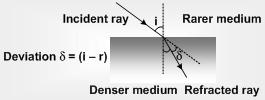
(v) When a ray of light goes from a denser medium to a rarer medium, it bends away from the normal.
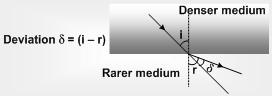
Refractive Index
(i) Refractive index of a medium is that characteristic which decides speed of light in it.
(ii) It is a scalar, unit less and dimensionless quantity.
(iii) Absolute refractive index:
When light travels from vacuum to any transparent medium then refractive index of medium w.r.t. vacuum is called it's absolute refractive index i.e. vacuumµmedium = c/v
Absolute refractive indices for glass, water and diamond are respectively µg = 3/2 = 1.5, µw = 4/3 = 1.33 and µD = 12/5 = 2.4
(iv) Relative refractive index:
When light travels from medium (1) to medium (2) then refractive index of medium (2) w.r.t. medium (1) is called it's relative refractive index i.e. 1µ2 = µ2/µ1 = v1/v2 (where v1 and v2 are the speed of light in medium 1 and 2 respectively).
(v) When we say refractive index we mean absolute refractive index.
(vi) The minimum value of absolute refractive index is 1. For air it is very near to 1. ( 1.003)
(vii) Cauchy's equation : µ = A + B/λ2 + C/λ4 + ... (1Red > 1Violet so mRed < mViolet)
(viii) If a light ray travels from medium (1) to medium (2), then 1µ 2 =
µ2/µ1 =
λ1/
λ2 = v1/v2
(ix) Dependence of Refractive index:
(a) Nature of the media of incidence and refraction.
(b) Colour of light or wavelength of light.
(c) Temperature of the media : Refractive index decreases with the increase in temperature.
(x) Reversibility of light and refraction through several media:

(A) 1µ2 = 1/2µ1 (B) 1µ2x2µ3x3µ1 = 1 or 2µ3 = 1µ3/1µ2
Snell's law:
The ratio of sine of the angle of incidence to the angle of refraction (r) is a constant called refractive index
i.e. sin i/sin r = µ (a constant).
For two media, Snell's law an be written as 1µ2 = µ2/µ1 = sin i/sin r or µ1sin i = µ2sin r
Refraction Through Glass
Lateral Shift:
The refracting surfaces of a glass slab are parallel to each other. When a light ray passes through a glass slab it is refracted twice at the two parallel faces and finally emerges out parallel to it's incident direction i.e. the ray undergoes no deviation δ = 0 . The angle of emergence (e) is equal to the angle of incidence (i)
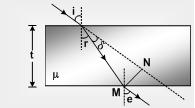
The Lateral shift of the ray is the perpendicular distance between the incident and the emergent ray, and it is given by MN = t secrsin (i – r)
Apparent Depth
When object is in denser medium and observer is in rarer medium
(i) µ = Real depth/Apparent depth = h/h'
(ii) Real > Apparent depth
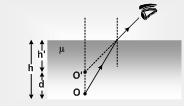
(iii) Shift d = h – h' = (1 – 1/µ)h.
(iv) If a beaker contains various immiscible liquids as shown then Apparent depth of
bottom d1/µ1 + d2/µ2 + d3/µ3 + ...


Object is in rarer medium and observer is in denser medium
(i) µ = h'/h
(ii) Real depth < Apparent depth.
(iii) d = (µ = 1)h
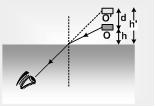
Total Internal Reflection (TIR)
When a ray of light goes from denser to rarer medium it bends away from the normal and as the angle of incidence in denser medium increases, the angle of refraction in rarer medium also increases and at a certain angle, angle of refraction becomes 90°, this angle of incidence is called critical angle (C).
When Angle of incidence exceeds the critical angle than light ray comes back in to the same medium after reflection from interface. This phenomenon is called Total internal reflection (TIR).
(i) µ = 1/sin C = cosec C where µ means; RaserµDenser
(ii) Conditions for Total Internal Reflection
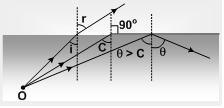
(a) The ray must travel from denser medium to rarer medium.
(b) The angle of incidence i must be greater than critical angle C
